| |
|
|
29.
| The Angel's Black Leg |
| |

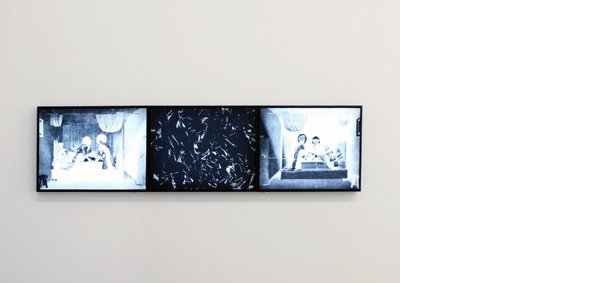
2011, triptych, prints on Duratrans, lightboxes, 70 x 100 cm each one.
Exhibition view from the Angel's Black Leg, Conrads Gallery, 2011, Düsseldorf.
Courtesy of the artist and ADN Galeria, Barcelona.
Ed. of 5 + 2 A.P.
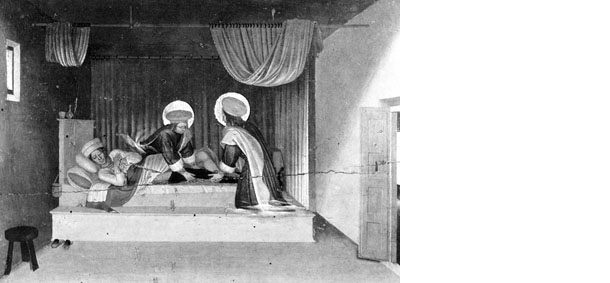
2011, triptych, prints on Duratrans, lightboxes, 70 x 100 cm each one.
Exhibition view from the Angel's Black Leg, Conrads Gallery, 2011, Düsseldorf.
Courtesy of the artist and ADN Galeria, Barcelona.
Ed. of 5 + 2 A.P.
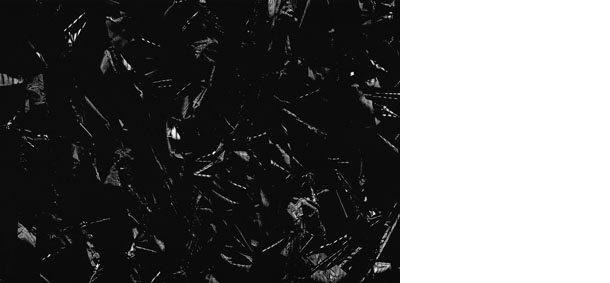
2011, triptych, prints on Duratrans, lightboxes, 70 x 100 cm each one.
Exhibition view from the Angel's Black Leg, Conrads Gallery, 2011, Düsseldorf.
Courtesy of the artist and ADN Galeria, Barcelona.
Ed. of 5 + 2 A.P.
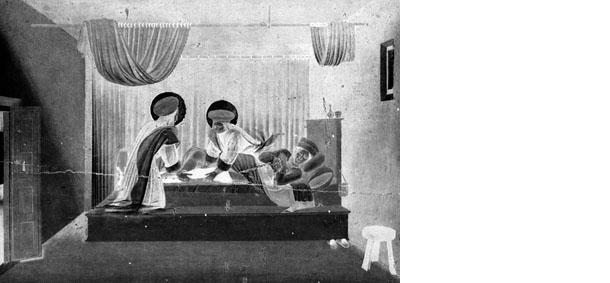
2011, triptych, prints on Duratrans, lightboxes, 70 x 100 cm each one.
Exhibition view from the Angel's Black Leg, Conrads Gallery, 2011, Düsseldorf.
Courtesy of the artist and ADN Galeria, Barcelona.
Ed. of 5 + 2 A.P.
'' This muddled identity, which is shared by all the characters in the Miracle of the Black Leg, necessarily intrigued the world of contemporary art. ''
Pierre-Yves Theler, 2015
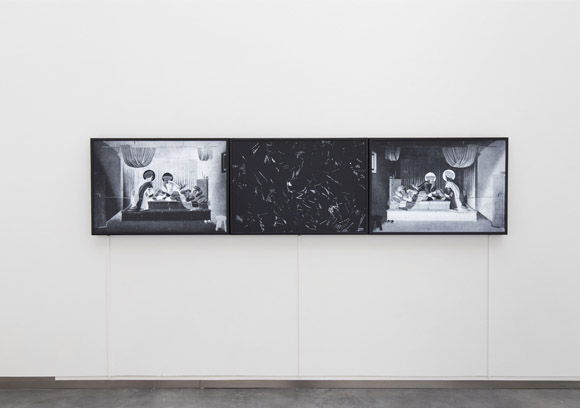
The Angel's Black Leg
Exhibition view from The Day of the Awakening, CDAN, 2018, Huesca.
Courtesy of the artist.
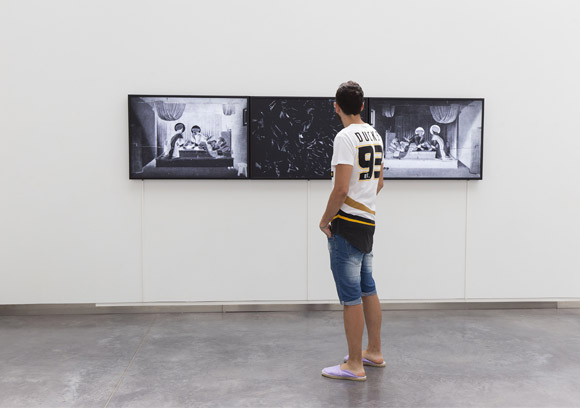
The Angel's Black Leg
Exhibition view from The Day of the Awakening, CDAN, 2018, Huesca.
Courtesy of the artist.
|
|
|
|
|
|
Le triptyque photographique La Jambe noire de l’ange s’inscrit dans une série d’œuvres de Mounir Fatmi intitulée La lumière aveuglante, inspirée d’un tableau du XVe siècle, La Guérison du Diacre Justinien, par le peintre italien Fra Angelico. Le tableau représente deux saints, Côme et son frère Damien, revenus à la vie pour effectuer une opération chirurgicale au cours de laquelle une jambe noire provenant d’un homme éthiopien récemment décédé est greffée sur le diacre. C’est une image frappante, inattendue et rare de voir cette fusion étrange de blanc et de noir, de mort et de vivant, de divin et de science. A l’aide de cette simple scène, Fra Angelico pose la question de la race, de l’hybridation et de l’identité. Nés en Syrie, Côme et Damien étaient arabes de naissance, puis se sont convertis au christianisme lorsqu’ils commencèrent à pratiquer la médecine, une vocation qui leur vaudra au bout du compte le martyre par décapitation. Ils sont considérés comme les saints patrons des pharmaciens.
Le triptyque La Jambe noire de l’ange est l’une des premières œuvres de ce projet au long cours. Imprimées en Duratrans et présentées dans des cadres rétro-éclairés, les images acquièrent une transparence créant un effet cinématographique, et le format des trois images évoque une bobine de film. Les images à double face sont comme des radiographies du tableau de Fra Angelico, en noir et blanc, les couleurs ayant été supprimées. La photo de gauche montre le tableau dans son aspect d’origine, le visage serein du diacre tourné vers le spectateur, les bras croisés. On peut y voir des noirs profonds : la jambe, le tabouret, les robes des saints, qui contrastent avec des zones de blanc étincelant : les auréoles des saints, les revers des manches de leurs robes. Dans la photographie à l’extrême droite, l’image du tableau a été inversée, tout comme les éléments auxquels on peut se référer. Les auréoles sont désormais noires, et la jambe blanche. Le diacre se fond dans l’arrière-plan du lit. La scène revêt un aspect fantomatique, comme si on la voyait à travers un filtre granuleux. Cette impression de regarder un agrandissement de capture d’écran est encore accrue dans l’image centrale où l’on peut voir un gros plan sur un amas de bande magnétique noire issue d’une cassette VHS. Les surfaces lisses et réfléchissantes sont entassées les unes contre les autres, créant une sorte de vide, comme s’il s’agissait d’images coupées lors du montage d’un film, l’image entre les captures d’écran, effacée.
Bien qu’il s’agisse d’images tirées d’un tableau du XVe siècle, leur transposition sous forme transparente et en noir et blanc les place dans un contexte contemporain qui évoque les obsessions de notre époque pour la chirurgie esthétique, les implants et les transformations physiques. Le triptyque efface ainsi les frontières entre l’ancien et le nouveau, entre le spirituel et le scientifique, pour montrer les connexions qui existent entre eux.
Blaire Dessent, mai 2017. |
|
The photographic triptych, The Angel’s Black Leg, is part of a series of work by mounir fatmi called The Blinding Light, which was inspired by a 15th century painting titled, The Healing of Deacon Justinian, by the Italian painter, Fra Angelico. The painting depicts two saints, Cosmas and his brother Damian, who have come back to life to perform a surgery in which a black leg, from an Ethiopian man recently deceased, is grafted onto the deacon. It is a striking image, unexpected and rare to this see this odd fusion of black and white, of living and dead, of the divine and of science. In this one scene Fra Angelico has questioned ideas race, hybridization, and identity. Born in Syria, Cosmas and Damian were Arab by birth and later converted to Christianity when they began practicing medicine, a calling for which they were eventually martyred by decapitation. They are considered the patron saints of pharmacists.
The triptych, The Angel’s Black Leg, is one of the earlier pieces in this ongoing project. Printed as Duratrans and presented in lightboxes, there is an added transparency to the images that creates a filmic effect, and the format of the three images resembles a strip of film. The two side images are like x-rays of the Fra Angelico painting, black and white, the color removed. The photograph on the left shows the painting in its correct presentation, with the Deacon’s serene face turned towards the viewer, his arms crossed. There are points of deep blacks, the leg, the stool, the robes of the saints, which contrast with spots of bright white, the saints halos, the cuffs of their robes. In the far right photograph, the image of the painting has been flipped, along with the reference points. Halos are now black, the leg, whitened out. The Deacon melts into the background of the bed. The scene feels ghostlike, as if viewing through a grainy filter. The impression of looking at enlarged film stills is re-emphasized in the central image which shows a close up of a bundle of black tape from a VHS cassette. The slick, reflective surfaces are crunched up together, offering a sort of void, as if this were the footage of a film that has been removed, the image in between the stills, erased.
Though we are looking at images of a 15th century painting, the shift into transparent, black and white images places it into a contemporary context that makes one think of current obsessions with plastic surgery, implants, and physical transformations. The triptych breaks down the division between old and new, the spiritual and the scientific, showing instead, the connections between them.
Blaire Dessent, mai 2017. |
|
|
|